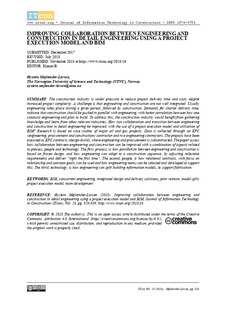| dc.contributor.author | Mejlænder-Larsen, Øystein | |
| dc.date.accessioned | 2019-09-19T12:27:26Z | |
| dc.date.available | 2019-09-19T12:27:26Z | |
| dc.date.created | 2019-02-14T08:33:24Z | |
| dc.date.issued | 2018 | |
| dc.identifier.citation | Journal of Information Technology in Construction (ITcon). 2018, 23 324-339. | nb_NO |
| dc.identifier.issn | 1874-4753 | |
| dc.identifier.uri | http://hdl.handle.net/11250/2617684 | |
| dc.description.abstract | The construction industry is under pressure to reduce project delivery time and costs despite increased project complexity. A challenge is that engineering and construction are not well integrated. Usually engineering takes place during a given period, followed by construction. Demands for shorter delivery time, indicate that construction should be pushed in parallel with engineering, with better correlation between how one conducts engineering and plan to build. To address this, the construction industry would benefit from gathering knowledge and learn from other relevant industries. How can collaboration and transition between engineering and construction in detail engineering be improved, with the use of a project execution model and utilization of BIM? Research is based on case studies of major oil and gas projects. Data is collected through an EPC (engineering, procurement and construction) contractor and two engineering contractors. The projects have been executed as EPC contracts (design-build), where engineering and procurement is subcontracted. The paper assess how collaboration between engineering and construction can be improved with a combination of aspects related to process, people and technology. The first, process, is how parallelism between engineering and construction is based on frozen design, and how engineering can adapt to a construction sequence, by adjusting milestone requirements and deliver “right the first time”. The second, people, is how relational contracts, with focus on relationship and common goals, can be used and how engineering teams can be selected and developed to support this. The third, technology, is how engineering can split building information models, to support fabrication. | nb_NO |
| dc.language.iso | eng | nb_NO |
| dc.publisher | International Council for Research and Innovation in Building and Construction | nb_NO |
| dc.rights | Navngivelse 4.0 Internasjonal | * |
| dc.rights.uri | http://creativecommons.org/licenses/by/4.0/deed.no | * |
| dc.title | Improving collaboration between engineering and construction in detail engineering using a project execution model and BIM | nb_NO |
| dc.type | Journal article | nb_NO |
| dc.type | Peer reviewed | nb_NO |
| dc.description.version | publishedVersion | nb_NO |
| dc.source.pagenumber | 324-339 | nb_NO |
| dc.source.volume | 23 | nb_NO |
| dc.source.journal | Journal of Information Technology in Construction (ITcon) | nb_NO |
| dc.identifier.cristin | 1677258 | |
| dc.description.localcode | Creative Commons licence CC-BY | nb_NO |
| cristin.unitcode | 194,61,50,0 | |
| cristin.unitname | Institutt for arkitektur og planlegging | |
| cristin.ispublished | true | |
| cristin.fulltext | original | |
| cristin.qualitycode | 1 | |

